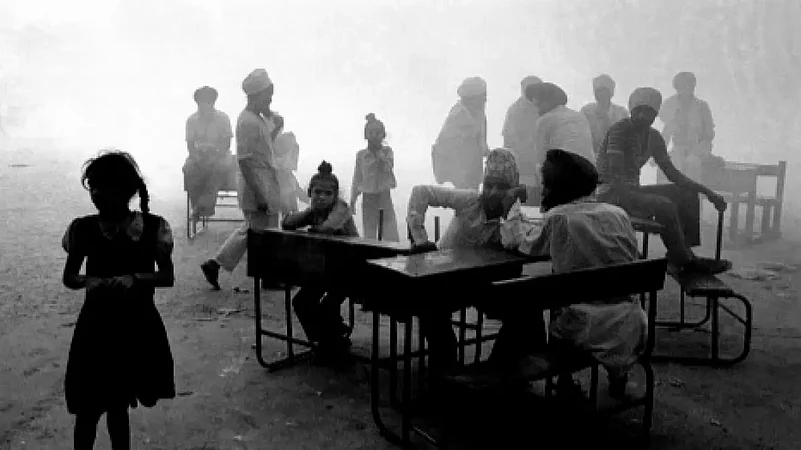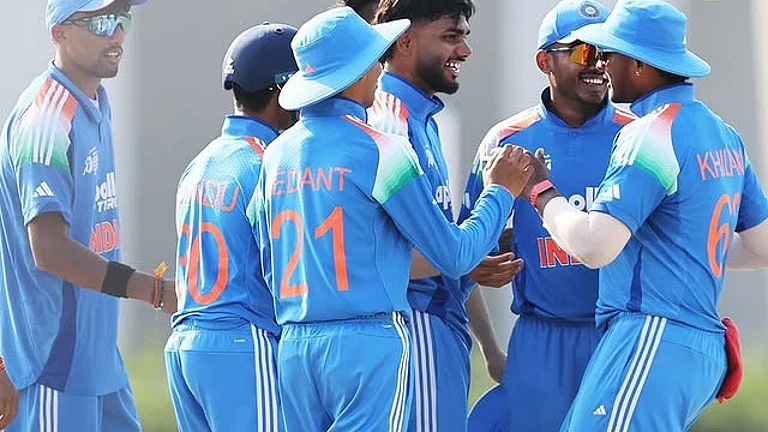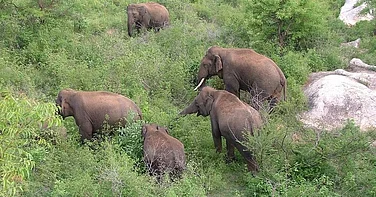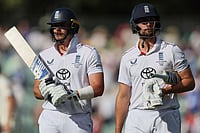Shamsul Islam taught political science at the University of Delhi. As an author, columnist and dramatist, he has been writing against religious bigotry, dehumanisation, totalitarianism, persecution of women, Dalits and minorities. He is known globally for fundamental research on the rise of nationalism and its development in India and around the world. In an exclusive interview with Abhish K Bose on the upcoming 40th anniversary of the gruesome incident, Shamsul discusses the massacre of the Sikh community members and the role of the RSS in it.

Here are the excerpts:
Abhish K Bose: You have worked among the survivors of the 1984 Sikh riots and have extensively written about your experiences and comments on the riots held by targeting the Sikh community members. Taking into account the rampant nature of the atrocities against the Sikh population and the organised nature of the attacks could you simply categorise the riots as orchestrated by some Congress leaders enraged over the assassination of Indira Gandhi by some of her Sikh bodyguards? Do you think there was any overt or covert support from any other organisations other than the aggrieved Congressmen in flaring up the fire?
Shamsul Islam: First, let me clear the air about the term ‘1984 Sikh riots’. It would be a misnomer to call 1984 ethnic cleansing of Sikhs as a riot. Riot is a situation when two groups are embroiled in a violent confrontation. Was it the case in 1984?
Absolutely not. It was pan-India, one-way, nasty and brutish campaign of annihilation of innocent Sikh females, males and children. Sikh women were raped with impunity. Their properties were looted or burnt, police and local goons organised orderly loot and provided safe exit to the perpetrators. The methods and tools used for cleansing of Sikhs in 1984 were an improvement over the inhumane practices of the killer gangs in earlier incidents of violence against minorities in India. Many Sikhs were put to death by slipping burning vehicle tyres to their necks thus prolonging their painful killing for many hours. The killers and crowd ‘enjoyed the tamashaa’ together.
It is unfortunate that violence against other minorities too is described a riot. It is true that I with members of Nishant Natya Manch, a street theatre group with which I am associated since 1971, joined other democratic and civil rights organisations in the relief work. But my main intervention was cultural. It was long before the October-November 1984 cleansing of Sikhs that Nishant was involved in countering the Hindu majoritarian narrative of demonising Indian Sikhs through street theatre and songs. 1984 started with ominous signs of majoritarianism culminating in June 1984 destruction of the major portions of the holiest shrine of Sikhism at Amritsar under the garb of Blue Star (ironically, this military campaign which burnt major parts of the Golden Temple and caused hundreds of deaths was named after a beautiful wild American flower!)
Nishant went around the country, especially in north India with a street play in Hindustani and Punjabi titled ‘Sadharan Log’ (common people) based on a play of renowned peoples’ theatre practitioner, Gursharan Singh, with the same title. It had four main characters―two Hindus, one bigoted and one common person with similar two Sikh characters. It was in the argumentative form highlighting and countering the stereotypes and denigration of Sikhs. Audiences were expected to join the debate. Every performance was preceded and followed by songs in Punjabi and Hindustani calling for unity of all common masses. I was part of the hundreds of performances and it was heartening to see audiences participating in the ‘garmaa-garm behes’, some resorting to abuses.
It is true that Congress leadership after the assassination of the then PM Indira Gandhi by her Sikh bodyguards on October 31, 1984, gave call to take revenge, but there were other forces―committed to turn India into a Hindu rashtra― involved in this project of cleansing of Sikhs in 1984.
Abhish K Bose: It is often claimed that the RSS cadres were involved in 1984. If true, why was their involvement not investigated?
Shamsul Islam: As a researcher of Hindutva politics and violence against minorities, Dalits and Bahujans, while investigating the 1984 cleansing of Sikhs I found that without doubt, the Congress leaders/cadres were behind this genocide. But there were other forces too which actively participated in this massacre and whose role has never been investigated. It could be one of the reasons that actual perpetrators remain unknown. Those who witnessed the genocide were stunned by the swiftness and military precision of the killer gangs―later on witnessed during the Babri mosque demolition, burning alive of Graham Steins with his two sons on January 23, 1999, the 2002 pogrom of the Muslims in Gujarat and the cleansing of Christians in Kandhmal region of Odisha in 2008―which roamed around India in 1984. This, surely, was beyond the capacity of the thugs led by many Congress leaders.
A crucial proof of this criminal collusion in the massacre of Sikhs is a document circulated by Nana Deshmukh, a prominent ideologue of the RSS (now deceased). Titled as ‘Moments of Soul Searching’ it was circulated by Deshmukh on November 8, 1984. This should help in unmasking a number of criminals involved in the massacre and rape of ordinary innocent Sikhs who had nothing to do with the killing of Indira Gandhi. This document may also throw light on where the cadres came from, who methodically organised the killing of Sikhs. Nana Deshmukh is seen outlining the justification of the massacre of the Sikh community in 1984.
The gist of this lengthy document can be summarised as follows:
a) The massacre of Sikhs was not the handiwork of any group or anti-social elements, but the result of a genuine feeling of anger;
b) Deshmukh did not distinguish the action of the two security personnel of Indira Gandhi, who happened to be Sikhs, from that of the whole Sikh community. According to his document the killers of Indira Gandhi were working under some kind of mandate of their community;
c) Sikhs themselves invited these attacks, thus advancing the Congress theory of justifying the massacre of the Sikhs;
d) He glorified the Operation Blue Star and described any opposition to it as anti-national. When Sikhs were being killed he was warning the country of Sikh extremism, thus offering ideological defense of those killings;
e) Sikh community as a whole was responsible for violence in Punjab;
f) Sikhs should have done nothing in self-defence but showed patience and tolerance against the killer mobs;
g) These were Sikh intellectuals and not killer mobs which were responsible for the massacre. They had turned Sikhs into a
militant community, cutting them off from their Hindu roots, thus inviting attacks from the nationalist Indians. Moreover, he treated all Sikhs as part of the same gang and described attacks on them as a reaction of the nationalist Hindus;
h) He described Indira Gandhi as the only leader who could keep the country united and because of her assassination, such killings could not be avoided;
i) Rajiv Gandhi, who succeeded Indira Gandhi as the PM, and justified the nationwide killings of Sikhs by saying, “When a huge tree falls there are always tremors felt”, was lauded and blessed by Nana Deshmukh at the end of the document;
j) Shockingly, the massacre of Sikhs was being equated with the attacks on the RSS cadres after the killing of Gandhiji and we find Deshmukh advising Sikhs to suffer silently. Everybody knows that the killing of Gandhiji was inspired by the RSS and the Hindutva Ideology whereas the common innocent Sikhs had nothing to do with the murder of Indira Gandhi; and,
k) There was not a single sentence in Deshmukh’s document demanding from the then Congress Government remedial measures to control the violence against the minority community.
Deshmukh circulated this document on November 8, 1984, and from October 31 to this date, Sikhs were left alone to face the killing gangs. In fact, November 5-10 was the period when the maximum killings of Sikhs took place. Deshmukh was just not bothered about all this.
This document also shows the true degenerated and fascist attitude of the RSS towards all minorities of India. The RSS has been arguing that they are against Muslims and Christians because they are the followers of foreign religions. Here we find them justifying the butchering of Sikhs who according to their own categorisation happened to be the followers of an indigenous religion. In this document, we come to know that the RSS, like the then Congress leadership, believed that the massacre of the innocent Sikhs was unavoidable.
This document was published in the Hindi Weekly Pratipaksh edited by George Fernandes, who later became Defence Minister of India.
Abhish K Bose: Is there any other evidence which can substantiate the role of the RSS cadres in the massacre?
Shamsul Islam: The involvement of the RSS cadres in 1984 Sikh massacre is doubly confirmed by many other happenings. Former Prime Minister Manmohan Singh in a speech in Parliament on August 12, 2005 offered an apology as a Congressman to the nation for the 1984 anti-Sikh violence, stating, “I have no hesitation in apologizing to the Sikh community. I apologise not only to the Sikh community, but to the whole Indian nation because what took place in 1984 is the negation of the concept of nationhood enshrined in our Constitution.”
This apology was included in NCERT school textbooks. It was not acceptable to the RSS. A senior RSS ideologue, Dina Nath Batra, on behalf of RSS-affiliated Shiksha Sanskriti Utthan Nyas demanded in July 2022 that the NCERT must remove this apology with other references to the violence against minorities from the textbooks. As if this was not enough, on the eve of the 2019 Republic Day, the RSS/BJP rulers of India bestowed the highest national award Bharat Ratna on Deshmukh who had justified the cleansing of Sikhs in 1984. Prime Minister Narendra Modi praising Deshmukh, said: “He personifies humility, compassion and service to the downtrodden. He is a Bharat Ratna in the truest sense.”
But why was the RSS involvement in the 1984 massacre of Sikhs was not investigated? It was a monumental blunder committed consciously by pro-Hindutva elements in the top hierarchy of the police and administration. Another reason could be the public support of the RSS to Rajiv Gandhi taking over as PM of India. The RSS’ English organ, Organiser in its combined issue dated November 11 & 18, 1984 carried an editorial titled 'Stunning Loss' which praised Indira Gandhi and wished all the best to Rajiv Gandhi in the following words:
“It will always be difficult to believe that Indira Gandhi is no more. One had got so used to hearing her myriad voices for so long, that everything looks so blank without her. The violent manner of her death is the most shocking horror story giving the nation the creeps… It is a case of treacherous fanatics stigmatising the whole nation by butchering a remarkable specimen of Indian womanhood… She literally served India to the last drop of her blood according to her own lights.” The same editorial ended with the words supporting the newly installed PM, Rajiv Gandhi, who “deserves sympathy and consideration”.
Abhish K Bose: Researchers of Hindutva politics have found that the RSS and violence are synonymous. What are the earlier examples of its involvement in anti-minority violent acts, especially in the post-Partition violence?
Shamsul Islam: RSS was not only involved in horrendous violence against Muslims in the post-Partition period, but also in pre-Partition and in the course of Partition. It is proved by the contemporary authentic narratives. Ram Lall Dhooria and his family lived in the town of Haveli Lakha, District Montgomery (now rechristened as Sahiwal) of western Punjab in pre-Partition India. Haveli Lakha, like many neighbouring towns in the western Punjab, had a mixed population of Muslims, Hindus and Sikhs. According to his autobiographical note, Dhooria was about 10 or 11 years old when he joined the RSS in 1942 and started attending its daily shakha (drill) held in an enclosure in the town where Muslims were in majority. He was forced to migrate to India along with millions other Hindus and Sikhs due to Partition, but he also got disillusioned with the blood-thirsty views and acts of the RSS against Muslims. After migrating to India and while teaching at the University of Delhi, he penned “I was a Swayamsewak: An Inside View of the RSS”, which not only provided a firsthand account of the debased activities of the organization, but how the RSS instigated violence against Muslims in areas where non-Muslims were in a minority.
He stated: “I thought of the two handsome children back in my home-town (Haveli Lakha) who had been murdered and thrown into a discarded well outside the town. They were the children of the Sheikh who ran a bookshop in the town’s only bazaar [market].”
“It was alleged that a RSS volunteer had done the hellish thing. At the time, I did not believe the story. Some days, later, I learnt about who had murdered those innocent children. What I heard substantiated the suspicion. The atmosphere had been sought to be vitiated by bunch of over-zealous RSS members egged on the murderous act by another RSS worker from Montgomery.
“Years later, I met him in Saharnapur in western Uttar Pradesh and asked him about it. He made no bones about his role in the whole affair, though he confessed that at times he experienced “the compunctious visiting of remorse…”
What devilish role the RSS played during the Partition is described by none other but the first home minister of India, Sardar Patel, who is a favourite of the RSS. In a letter (September 11, 1948) written to M S Golwalkar, the second supremo of the RSS, Patel stated: “Organizing the Hindus and helping them is one thing, but going in for revenge for its sufferings on innocent and helpless men, women and children [of the Muslim community] is quite another thing… It was not necessary to spread poison in order to enthuse the Hindus and organise for their protection. As a final result of the poison, the country had to suffer the sacrifice of the invaluable life of Gandhiji.”
Abhish K Bose: Did the scars of the 1984 Sikh riots still persist or are obliterated? Did you revisit the places and interact with the survivors or their posterity so as to know their current whereabouts?
In certain places near Ahmedabad in Gujarat where large-scale Hindu-Muslim riots took place in 2002, the two communities no longer live together. Both communities are living in their exclusive places with no connection with other community members. Is it the same with the survivors of the 1984 Sikh riots?
Shamsul Islam: The perpetrators of the violence wish that all traces of their criminal acts are forgotten or obliterated, but victims never forget the treatment meted out to them. Even if they were unable to take revenge, they wait even for decades to settle accounts or their sorrowful stories become part of their folklore. Take the example of Jallianwala Bagh Massacre of April, 1919. The colonial masters saw to it that in Britain this horrible incident of repression remained under wraps. But the great martyr, Udham Singh (re-naming himself as Mohammad Singh Azad in order to underline the necessity of unity of Hindus, Muslims and Sikhs in the anti-colonial struggle), took revenge by assassinating Michael O’Dwyer (chief of the British administration of Punjab at the time of the massacre) on March 13, 1940 in London. He was hanged on July 31, 1940 in a jail in London. He waited almost for 21 years to take revenge.
I have been in touch with many of the victims. Many of them are close family and political friends. It is true that many of them have moved on financially, but the tragedy continues its devastating run in the case of hundreds of Sikh widows and those Sikh children and youngsters who witnessed the massacre. Many of the young lives were lost to drugs and suicides. The poor Sikhs were forced into ghettos or migrate to Punjab.
In the case Muslim victims of the carnage in Gujarat in 2002, the tragedy continues to unfold; in fact, it has aggravated with the running amok of the Hindutva juggernaut. The major parts of every city in Gujarat became out of bounds even for the rich Muslims. Now we have Muslim ghettos of the well-off as well as poor. Since most of the Muslim victims were poor artisans or marginal farmers, they were reduced to the status of paupers.
(A journalist having fifteen of years of experience Abhish K Bose was a staffer of The Times of India and The Deccan Chronicle - Asian Age. As a contributor, his interviews and articles have been published in Frontline magazine, The Wire, The Print, The Telegraph, The News Minute, Scroll, The Kochi Post, Outlook.com, The Federal and the Asian Lite international published out of Manchester.)





















